Survey quotas
From LimeSurvey Manual
Introduction
A quota is used to set a limit on responses from defined groups of people on an active survey. Some common attributes used in defining quotas are things like gender, age, race, province/state. To access the survey quotas panel, access the survey menu and select the Survey quotas tab:
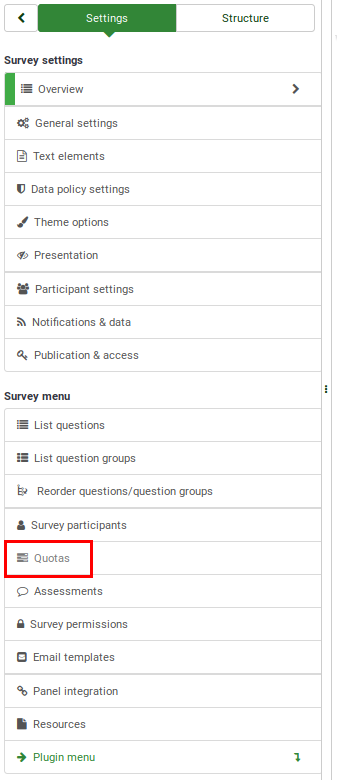
How do quotas work
To understand how the quota system in LimeSurvey is working, think of a survey that contains a "Yes or No" question and an Array question, each of them belonging to two different question group. You set a quota on this survey that contains a restriction of 20 users who have answered "Yes" to this question. The quota will be checked every time somebody answers "Yes" to that question.
Depending on the format of your survey (how the questions are displayed to your respondents), the check happens either when you submit:
- the whole survey: If the format of the survey is all in one, the survey questions (regardless of the question group they belong to) will be displayed on the same page. Therefore, the user has to press the submit button in order to trigger the quota system.
- the answers to that specific question group: If the format of the survey is group by group, then the quota gets activated when the user has responded to all the questions from the question group where the answer where the quota is applied to is located in. Therefore, the quota may get triggered before the end of the survey if the question group is located in the beginning of the survey.
- or the answer to that specific question: If the format of the survey is question by question, each question will have a page allocated. If you select the answer to which the quota is applied to, the quota system will get automatically triggered once you press the Next button.
If "No" is chosen, the quota system is never triggered. Therefore, the survey won't restrict anyone from responding the rest of the questions, unless otherwise specified.
To set a limit on the number of "No" responses, you need to add an additional quota, restricting the number of participants who choose "No".
Using more answers and quotas
You might have to conduct a survey where you want to limit it to 25 male and 30 female respondents. You could then define a quota with a limit of 25 for the answer "Male" from your gender question in the survey. Another quota for the answer "Female" with a limit of 30 could be added as well. This will give you a maximum of 25 males who will be able to complete the survey, and a maximum of 30 females who can complete the survey.
Let's suppose now that you want 50 answers from males and 50 answers from females. Please note that each answer that triggers the quota must be introduced in its own quota box. Adding the two answers in the same box will result in collecting 50 answers, regardless of the gender of the respondent (the distribution can be 40 males and 10 females, or 20 males and 30 females, and so on). See the Examples subsection to better understand the usage of the quota system.
Activating the quota system even if you have entries in the responses table
Note that a quota system does not necessarily have to be added at the beginning of the survey. For example, you can activate it after one week since you first activated the survey. Once you did this, the respondents will still be allowed to complete your survey.
However, from now on, if the answer (to which the quota is applied to) is selected, the quota system will check the survey responses table and look for those entries that are marked as being complete. Then, it checks if the quota condition is respected or not. For example, if you have previously gathered 1000 answers from women and you introduced the quota of 800 for women, then the next answers from women will be stored completely or incompletely (depending on the way in which the questions are displayed) and marked as being incomplete.
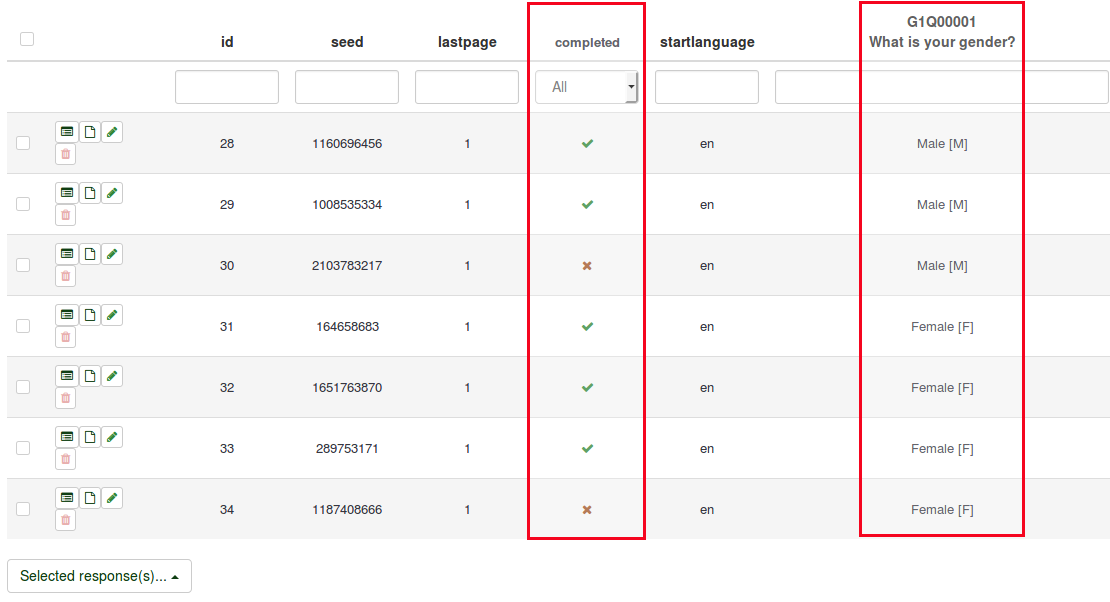
The quota system does not store any answers! Think of it as a filtering process that is applied on the survey responses table that works with the completed column and the question columns where the answer to which a quota is applied to is contained.
Supported question types
The quota system can be applied only to the following types of questions at the moment:
- Gender
- Multiple Choice
- Array - 5 Point Choice
- Array - 10 Point Choice
- Language Switch
- Yes/No
- List (Radio)
- List (Dropdown)
- List with comments
Survey quotas panel
Once you click on the Survey quotas tab from the survey menu, the following page will load up:

To see the full set of options of this panel, add one survey quota. Then, the survey quota page will look like this:

The following options are available:
- Add new quota: Located on the bottom right part of the survey quotas table, it allows users to add new quotas. Once quotas are displayed on the table, you can start implementing them to certain questions/subquestions answers;
- Add an answer: Before adding an answer, you need to add a quota within which the answer(s) will be stored in. The quota limit will be applied only to those answers displayed in the quota box.
- Edit quota: Click on the green pencil located under the Action column of the survey quotas table to edit the fields of a quota;
- Delete quota: Click on the red trash button located under the Action column of the survey quotas table to delete the respective quota entry;
- Quota validation: Click on the last button located under the Action column of the survey quotas table to quickly check the quota message displayed to the respondents, the URL (and/or a short description of it) where they will be redirected;
- Quick CSV report: It exports a summary of the quotas under the form of a CSV comma-delimited table.
- Selected quota(s)...: It works like an aggregator. If you wish to apply one of the actions specified below to more than one quota, use this button to fasten the process.
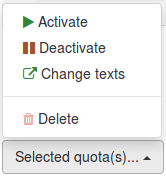
- Activate: Use this button to activate a quota. The active ones have the quota name, action, and URL written in white font on a green background.

- Deactivate: Use this button to deactivate a quota. The deactivated ones have the quota name, action, and URL written in black font on a grey background.

- Change texts: Use this button to quickly change the quota message, URL, and URL description of a group of a quotas. You may use this function to redirect respondents to a certain link once different quota conditions were met.
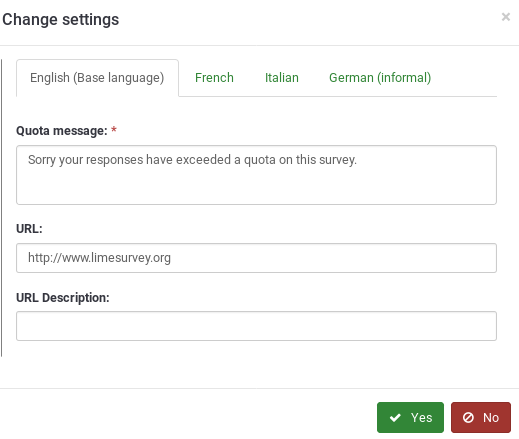
- Delete: If you wish to delete several quotas in the same time, tick the ones you wish to delete, click on the selected quota(s) button and select the Delete option.
Add new quota
For a fully working quota you must firstly "add a quota", and then "add answers" to that quota.
Once you click on the Add new quota button, the following page will be displayed:
The fields marked with a star have to be filled in.
The following options are available:
- Quota Name: This represents the name of the quota that will be displayed on the survey quotas table. It should describe the quota it will represent;
- Quota Limit: It represents the maximum number of completed surveys that will be stored in the responses table. The limit will be checked every time a certain answer is selected and the whole survey is completed;
- Quota Action: This is an action to perform when a participant is filling out a survey and lands up being part of a quota that has become full.
- Terminate survey: This immediately terminates the survey, and closes the interview.
- Allow user to modify his last answers before terminate survey: Useful action when you want a respondent not to sign up/choose anymore a certain category. For example, when goodies are offered, you can use a quota on each option in order not to have more users selecting the same good.
- Autoload URL: This tells LimeSurvey to automatically redirect the participant to the URL when the quota action occurs.
- Quota Message: Write the text you wish to be displayed to your respondents if the quota action is triggered. The message will be displayed if the Autoload URL is disabled.
- URL: The URL displayed to survey participants after the quota action was triggered. The users can also be automatically redirected to this URL if "Autoload URL" is enabled. You can use URL fields in this section.
- URL Description: A short URL description can be added in order to show to the other survey administrators the goal of the URL for example.
Add an answer
Once the quota was created, you can start adding answers under it. To do that, access the Survey quotas panel. Look into the survey quotas table and select the Add answer option from the quota box where you wish to add the respective answer to:
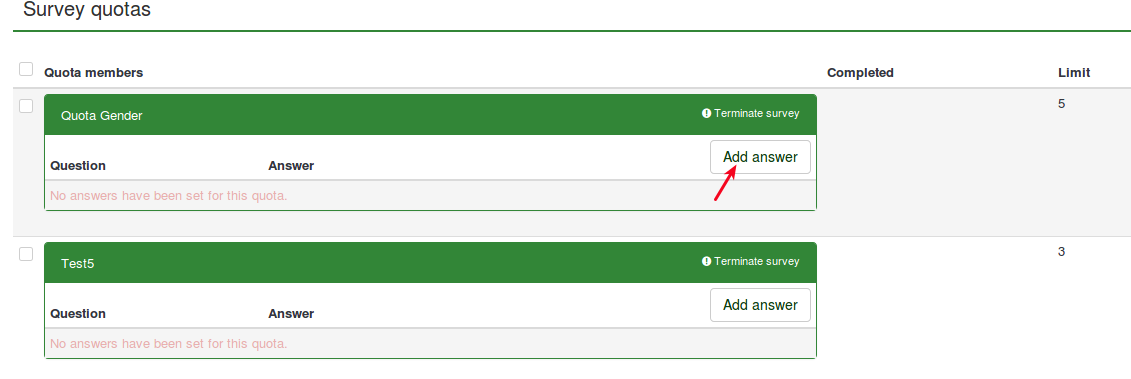
After you clicked it, a new page will load up asking you to select the question to which the quota will be applied to:
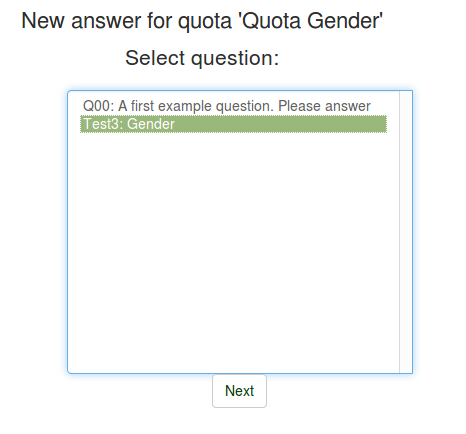
Once you click next, the answers of the question you selected one step before will be displayed. Now, you have to choose to which answer you wish the quota to be applied to:
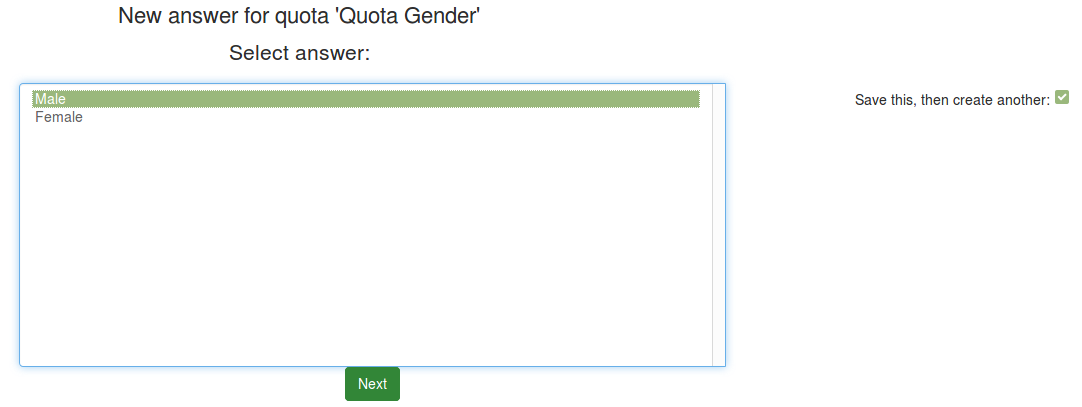
In this example. the "Male" answer will have the quota applied to it. Whenever respondents choose this option. the quota system registers the answer. Once the quota limit is reached, the stored survey answers will still be saved in the responses table, but it will be marked as being incomplete.
Quick CSV report
The quick CSV report function is used to export the survey quotas table in a comma-delimited CSV file. It includes the following fields:
- Quota name: The name of the quotas;
- Limit: The maximum number of responses that will be marked as being "complete" in the survey responses table;
- Completed: The number of survey answers marked as being "complete" in the survey responses table. An answer is marked as being "incomplete" if the quota is triggered.
- Remaining: The number of answers that can still be collected in the survey responses table and marked as being "complete" there.
Quota and tokens
When tokens are used in a survey and the user is screened out due to a quota, then the respective token entry from the survey responses table is marked with the letter "Q" in the completed column. The token is invalidated in this way and the survey participant cannot restart the survey.
Examples
The role of the following examples is to better explain the role of quotas and their usage within the LimeSurvey environment. Before continuing reading the below examples, please note that:
- answers added in the same quota are summed up. For example, if answers A and B from the available responses of the survey questions are added to quota Q1, the quota limit sums up the number of users who have answered A and B. Therefore, the distribution of A and B answers will be (highly probable) uneven.
- answers added in different quotas act as there is a logical operator "AND". Let's suppose that A is added to Q1 and B to Q2. If Q1 is reached, then respondents won't get their answers marked as being "complete" in the survey responses table. However, the survey respondents that choose B are still allowed to continue as long as Q2 is not reached. Once it is reached, then respondents who further choose A or B as answers to that specific question(s) will have their answers marked as being incomplete in the survey responses table.
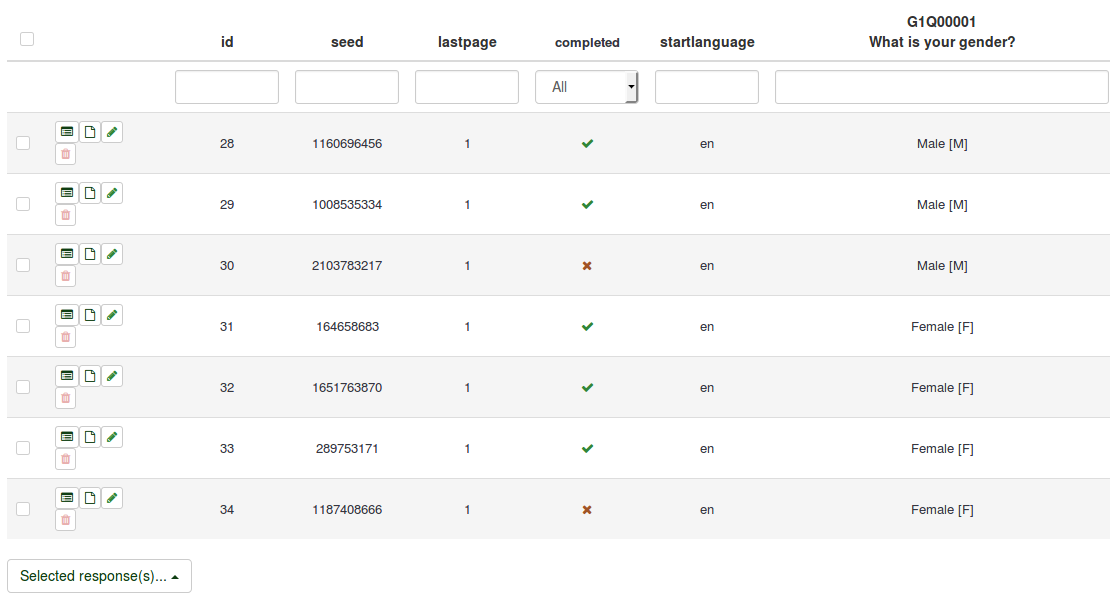
Adding more answers to different quotas
Let's assume that you are doing a survey about LimeSurvey and you would like to receive some feedback from your users. You would like to receive 1000 answers from students (PhD student, graduate, undergraduate) and another 1000 from non-students (unemployed person, full/part-time working person or other). In order to do this, create two quotas: Students quota and Non-students quota.

Now, start adding answers to each quota box following the steps described above in the Add an answer| wiki section. The quota boxes should look like this:

By using this method, you limit the number of responses you receive from the two defined groups: students and non-students groups. Now, activate the survey and start testing the quotas. If you first reach 1000 answers from the non-students group, the answers will be marked as being incomplete in the survey responses table. Only answers that come from the students group will be accepted. Once it reaches 1000, no more answers will be registered as being complete in the survey responses table.
Adding a URL link
To add an URL link to a quota, please read in-depth about by accessing the URL fields wiki section.